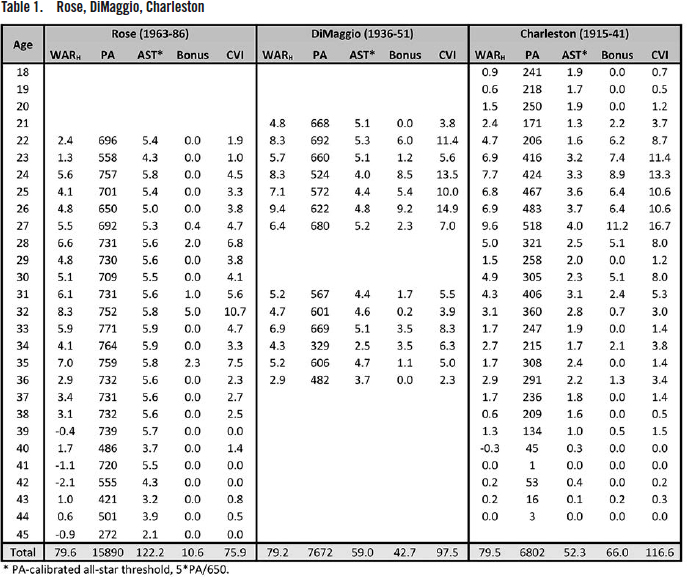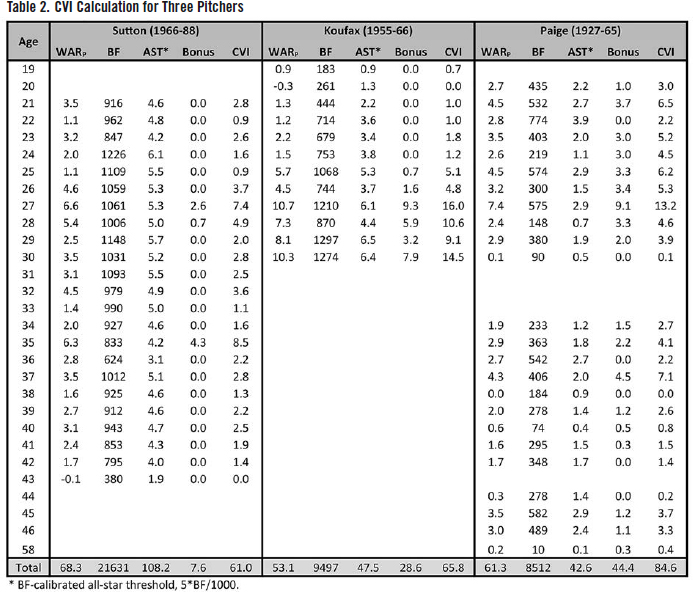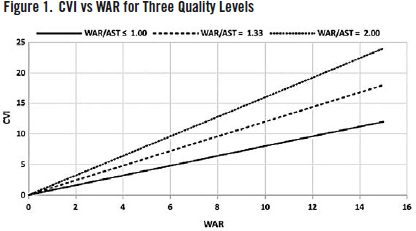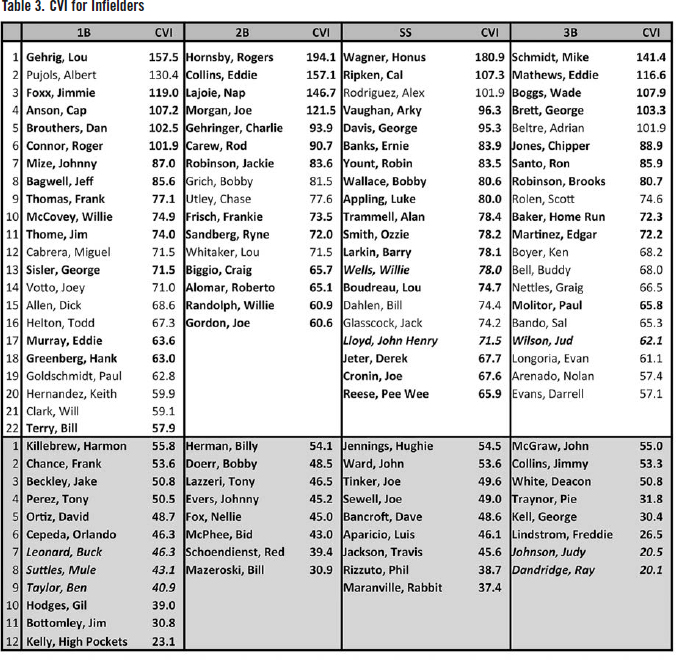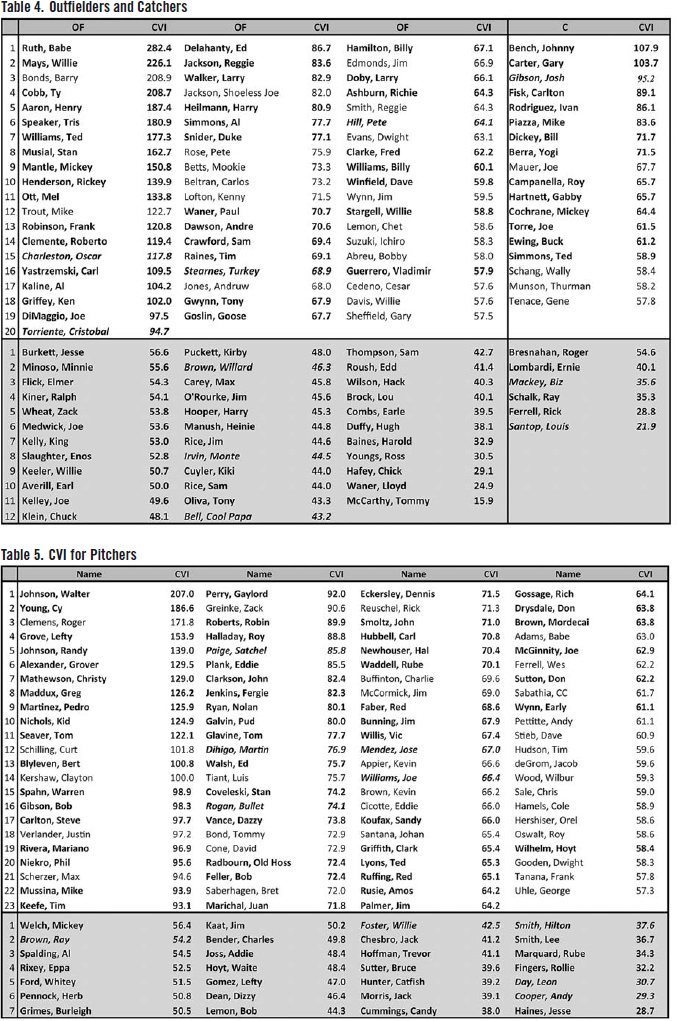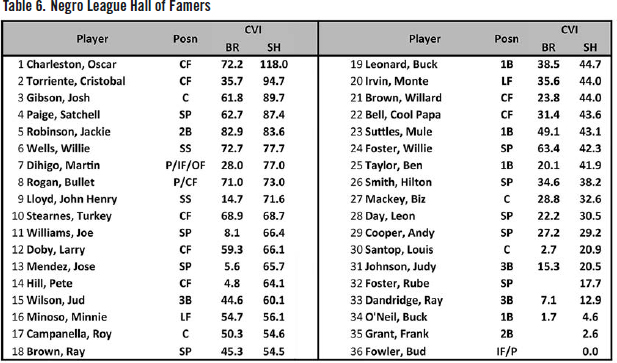Using Career Value Index to Evaluate Hall of Fame Credentials of Negro League Players
This article was written by David J. Gordon
This article was published in Fall 2022 Baseball Research Journal
A subject that animates baseball fans is ranking its greatest players, particularly regarding membership in the National Baseball Hall of Fame in Cooperstown (HOF). In the past decade or two, Wins Above Replacement (WAR) has moved to the forefront of this discussion among analytically minded fans. Unlike many “traditional” stats (wins, losses, saves, runs, RBI), which inextricably mix individual performance with the performance of teammates, WAR is based on a rigorous analysis of the elements of individual performance that contribute to a team’s ability to score or prevent runs. WAR also controls for differences in the scoring environment across historical eras and among ballparks in a particular year. Although there are several versions of WAR and its calculation is opaque, WAR values for every player are easily accessible in real time on websites like Baseball-Reference.com and FanGraphs.1,2 I will use the Baseball-Reference version here.
While WAR represents a huge step forward in baseball analysis, it is not really up to the task of assessing career value, since it gives too much weight to quantity and too little weight to peak performance. When we think of a Hall of Famer, we think of a player who was ideally among the best in the game over a significant stretch of time, rather than someone who was merely above average for a very long period of time. However, career WAR makes no distinction between a 70-WAR superstar, who averaged 7.0 WAR per year (near MVP level) for 10 years and made multiple AllStar appearances with an occasional MVP or Cy Young award, and a 70-WAR “compiler,” who averaged a good but unspectacular 3.5 WAR per year for 20 years and was rarely an All-Star. For example, WAR tells us that Don Sutton (66.7 WAR with 4 ASG, no MVP, no CYA in 23 years) had a better career than Sandy Koufax (48.9 WAR with 7 ASG, 3 CYA, 1 MVP in 12 years). HOF voters clearly believed Koufax to be superior: electing Koufax on the first ballot, while passing on Sutton until his fifth year on the ballot.
WAR is also highly dependent on the length of the schedule and on historical patterns of player usage, which have differed radically across the generations, especially for pitchers. For example, was Old Hoss Radbourn’s 19.2 pitching WAR in 678.2 IP (!) really better than Clayton Kershaw’s 7.7 pitching WAR in 198.1 IP in 2014, when he swept the NL Cy Young and MVP awards? Where does Mariano Rivera’s 53-save 2004 season (4.2 WAR in 78.2 IP) fit in? This “opportunity inequity” also suppresses WAR for hitters and pitchers in leagues playing shorter schedules. For example, Cap Anson never made more than 550 PA or accrued more than 6 WAR until 1886, when he was 34 years old.
In my 2021 book, Baseball Generations, I introduced Career Value Index (CVI) as a tool to evaluate the Hall of Fame (HOF) candidacy of players from the National and American Leagues and other leagues that were recognized as “major” before 2020, which a) placed premium value on players who were at or near the top of their league for multiple years—the longer the better—rather than on players who were merely good enough to hold a job for twenty years, and b) considered historical opportunity inequities—particularly among pitchers of different eras.3 The tool accomplished this by defining an “all-star threshold” (AST) of WAR corresponding to all-star quality performance, which differed for pitchers and non-pitchers and from season to season, and giving players triple credit for the amount by which their WAR in any particular season exceeded the AST for that season. The default value of the AST was 5.0 in 1924–67, but it ranged from as high as 11.0 for pitchers in Radbourn’s heyday (1883–84) to 4.0 for modern pitchers, and dipped as low as 2.0 for 1871–78 position players and for all players in the 60-game 2020 pandemic season.4 The original version of CVI also contained numerous customized secondary adjustments, including adjustments for catchers, designated hitters, and relief pitchers, discounts for PED use, and credits for time lost to wartime military service or years lost to enforcement of the color barrier.
The Jaffe WAR Score (JAWS), first introduced in 2002, takes a different approach to valuing players who were dominant in their prime by awarding double weight to a player’s seven best seasons of WAR.5 However, Sutton’s 50.3 JAWS still beats out Koufax’s 47.4. As we shall see, CVI (like the HOF electorate) assigns the higher career value to Koufax. Furthermore, until the recent introduction of S-JAWS, which attempts to control for the large WAR scores accrued by the work-horse pitchers of the nineteenth and early twentieth, JAWS did nothing to address opportunity inequity.6
Unfortunately, neither JAWS nor the original version of CVI is sufficiently flexible to accommodate the Negro Leagues, seven of which have now been recognized as major leagues by both SABR and MLB.7 Negro League schedules varied between 50 and 100 games, and tended to get shorter after the demise of the first Negro National League in 1931. Many prominent Negro League players (Oscar Charleston, John Henry “Pop” Lloyd, Smokey Joe Williams, etc.) began their careers well before 1920. Even after 1920, other players (Josh Gibson, Satchel Paige, Martin Dihigo), looking for bigger paychecks, played significant portions of their careers in Cuban, Mexican, and other independent leagues, which have not yet been recognized as “major” by MLB. Furthermore, before 1930, Negro Leaguers often played in a summer league, a winter league, and on barnstorming all-star teams within a single 12-month period. One would have to customize the original CVI formula (CVI 1.0) one player at a time to accommodate this complexity. In this article, I will present a generalized streamlined version of CVI (henceforth referred to as CVI 2.0), which yields similar results to CVI 1.0 for most players in the other major leagues but also accommodates the Negro Leagues.
METHODS
While CVI 1.0 evaluates WAR against a threshold (the AST) that is defined season by season, CVI 2.0 evaluates WAR against a threshold that is calibrated to plate appearances (PA) for position players and batters faced (BF) for pitchers. This calibration of AST to PA and BF makes it possible to automate the CVI calculation rather than customize it one season at a time. CVI 2.0 uses a “standard” season of 650 PA for hitters and 1000 BF for pitchers to define the AST as 5*PA/650 for position players and 5*BF/1000 for pitchers. The general formula for CVI for any season is the sum of CVIH and CVIP, where
The subscripts H and P in these equations refer respectively to the hitting and pitching components of CVI, WAR and AST. As in CVI 1.0, all negative WAR values are rounded up to zero. In CVI 2.0, AST=5.0 (the default threshold for 1924–67 in CVI 1.0) for all hitters with 650 PA and all pitchers with 1000 BF, no matter which league or which season. The 650 PA standard for position players corresponds to the workload of a typical, everyday, middle-of-the-order hitter and has been stable for more than a century (excepting work stoppages and pandemics). In 2022, for example, Paul Goldschmidt, Josh Bell, Anthony Santander, Randy Arozarena, and Nathaniel Lowe all had 645–655 PA; 27 players, mostly durable top-of-the-order types, led by Marcus Semien’s 724 PA, had ≥655 PA. The 1000 BF standard corresponds to a typical workload for AL and NL starting pitchers between (roughly) 1909 and 1988. Some examples of pitchers with 996–1004 BF are Red Faber (1917), Burleigh Grimes (1929), Whitlow Wyatt (1940), Allie Reynolds (1952), Whitey Ford (1965), Ed Figueroa (1977), and Rick Reuschel (1988). In 1871 through 1908, BF totals above 1500 were common and approached 3000 in 1879–92. Since 1989, BF totals ≥1000 have become increasingly rare; the last pitcher to attain this milestone was David Price (1009) in 2014. In 2022, Sandy Alcantara led MLB with 886 BF.
I will illustrate the calculation of CVI using Shohei Ohtani’s 2022 stats as an example. In 2022, Ohtani accrued 3.4 WAR in 666 PA as a hitter and 6.1 WAR in 660 BF as a pitcher. To calculate Ohtani’s CVI as a hitter, we first calculate that his ASTH=5*666/650=5.12. Since his WARH was only 3.4 (i.e., less than his ASTH), he gets no bonus, and his CVIH=0.8*3.4=2.72. To calculate Ohtani’s CVI as a pitcher, we first calculate that his ASTP=5*660/1000=3.3. Since his WARP exceeded his ASTP by 2.8 he gets a bonus of 5.6. His CVIP is therefore 0.8*(6.1+5.6)=0.8*11.7=9.36. Adding his CVIH and his CVIP gives Ohtani a total CVI of 12.08 for the 2022 season.
All non-Negro League data in this article come from Baseball-Reference.com.8 For the Negro Leagues, I have used PA, BF, and WAR data from the Seamheads.com database, which includes data from leagues that have not been officially recognized by MLB and may include some games against lesser competition.9 For those Negro League seasons where BF data are unavailable, I have approximated BF as 0.98*(3*IP+H+BB+HBP). The empirically derived 0.98 factor adjusts for the fact that the expression in parentheses does not include players who reach base on error, catchers interference, etc. and double counts double plays, triple plays, and baserunning outs. Also, the WAR calculation formulas in Seamheads may not match those used in Baseball-Reference. Nevertheless, I have erred on the side of inclusiveness, since restricting my consideration to officially recognized leagues would grossly undervalue the careers of many Negro Leaguers, especially those who played before 1920.
Note that Negro League statistics are a work in progress and that new data are periodically being added to both databases as research uncovers previously untallied box scores and game articles. Even the statistics of the AL and NL are not written in stone since Baseball-Reference tweaks its WAR formula at least once a year. Thus, the WAR and CVI calculations in this article, which are complete and accurate through October 24, 2022, will undoubtedly change— perhaps even before this article is published.
I have retained two secondary adjustments from CVI 1.0: 1) the PED adjustment, which applies a 20% WAR penalty for hitters and a 10% penalty for pitchers for seasons with sufficient evidence of PED use, and 2) a modified positional adjustment for catchers, in which their WAR for each season is multiplied by a factor of 1+.001*games caught.10 So, for example, the WAR of a player who appeared in 100 games as a catcher that season is multiplied by 1.1. This correction puts catchers (who suffer greater wear and tear and whose game calling and other intangibles are not captured by WAR) on a more level playing field with other positions. The other secondary adjustments in CVI 1.0 have been dropped, since they rely on projection and cannot be automated.
EXAMPLES OF CVI CALCULATION
I have selected three examples of position players with similar WARH (Table 1) and three examples of pitchers with similar WARP (Table 2) to illustrate how CVI elevates superstars with abbreviated careers (DiMaggio and Koufax) over compilers (Rose and Sutton) with lesser peak value and how it compensates for opportunity inequity. Table 1 features Pete Rose, Joe DiMaggio, and Oscar Charleston, while Table 2 features Satchel Paige, Sandy Koufax, and Don Sutton.
Note that Charleston’s age 19, 20, 24, and 27 seasons include his winter (as well as summer) league stats for those years. Tables 1 and 2 do not include the small pitching contribution of Charleston (-0.8 WAR, 1.1 CVI) or the small hitting contributions of Sutton (-1.6 WAR, 1.2 CVI), Koufax (-4.2 WAR, 0.4 CVI), or Paige (-1.8 WAR, 1.0 CVI).
Rose played for nine years longer than DiMaggio (who was injured frequently and missed three years in World War II) and amassed more than twice as many PA. But DiMaggio’s WAR exceeded his AST in 13 of his 15 seasons, while Rose exceeded this threshold only five times in 24 seasons. Rose won an MVP and two World Series championships, but DiMaggio far surpassed Rose with three MVP awards and nine World Series championships. Thus, while Rose had a slightly higher WAR, CVI recognizes the superiority of DiMaggio. Similarly, CVI recognizes Koufax, whose WAR exceeded his AST threshold in each of his last six seasons as a greater star than Sutton, who had 15 more WARP than Koufax but faced more than twice as many batters (Table 2). CVI also recognizes the superiority of Charleston (who attained 79.5 WAR in only 6802 PA) over Rose and DiMaggio and the superiority of Paige (who attained 61.3 WAR in only 8512 BF) over Sutton and Koufax.
While CVI 2.0 is designed to reward quality of performance, it reflects volume as well. This is in contrast to metrics like OPS+, ERA+, and WAR per 162 games, which focus solely on quality. CVI 2.0 compensates for opportunity inequity not by projecting the WAR a player actually accrued to 650 PA or 1000 BF, but by adjusting the standard to which that player’s actual WAR is compared (i.e., the AST); no projections or extrapolations are made. For example, in Table 1, Oscar Charleston at age 23 (1920) and Joe DiMaggio at age 33 (1948) each had seasons of identical “volume”—i.e., 6.9 WAR—but Charleston had the higher quality, accruing his 6.9 WAR in 416 PA versus 669 PA for DiMaggio. So, Charleston scores higher in CVI, 11.4 to 8.3.
In another example, Sandy Koufax at age 27 (1963) and Satchel Paige at age 23 (1930) had seasons of near identical quality as measured by WAR/AST (1.77 for Koufax versus 1.74 for Paige), but Koufax had three times the volume (10.7 WAR in 1210 BF versus 3.5 WAR in 403 BF). Although their seasons were of similar quality, Koufax’s quantitative superiority translates to a 16.0 to 5.2 advantage in CVI for those seasons.
Moving from the particular to the general, Figure 1 illustrates how CVI increases with both volume of performance (as measured by WAR) and quality of performance (as measured by WAR/AST). At each quality level, CVI increases linearly with WAR. When WAR/AST≤1, there is no bonus and CVI=0.8*WAR (or zero if WAR<0). When WAR/AST=1.33 (e.g., DiMaggio’s 1948 season), the slope increases to 1.2. When WAR/AST=2.0, which often translates to MVP or Cy Young level performance over a full season (e.g., DiMaggio’s 9.4-WAR 1941 season), the slope increases to 1.6.
Only 34 seasons with unadjusted WAR/AST≥2.2 over at least 750 BF or 500 PA have been recorded. Aaron Judge’s 10.6 WAR in 696 PA in 2022 translates to WAR/AST 1.98—outstanding, but not one of the 34. The 34 are:
WAR/AST ≥ 2.4: Babe Ruth (2.64 in 1923, 2.51 in 1920, 2.42 in 1921), Pedro Martinez (2.86 in 2000), Rogers Hornsby (2.49 in 1924), Barry Bonds (2.49 in 2002), Greg 0Maddux (2.47 in 1995), Oscar Charleston (2.43 in 1924).
2.3 ≤ WAR/AST < 2.4: Babe Ruth (1926, 1927), Barry Bonds (2001), George Brett (1980), Walter Johnson (1913), Mickey Mantle (1957), Pedro Martinez (1999), Honus Wagner (1908), Ted Williams (1957), Carl Yastrzemski (1967).
2.2 ≤ WAR/AST < 2.3: Roger Clemens (1990, 1997), Mookie Betts (2018), Barry Bonds (2004), Ty Cobb (1910), Dwight Gooden (1985), Zack Greinke (2009), Jacob deGrom (2018), Rogers Hornsby (1925), Hubert “Dutch” Leonard (1914), Mickey Mantle (1956), Willie Mays (1965), Joe Morgan (1975), Babe Ruth (1924), Ted Williams (1941).
PLAYER RANKINGS
We will now see how CVI plays out over the full range of potential HOF candidates over 152 years of baseball history and where the Negro Leaguers fit in. We will begin with the CVI results for infielders (Table 3). All infielders with CVI≥57.0 are listed in the upper (unshaded) portion of the table. Hall of Famers with CVI<57.0 are listed in the lower (shaded portion). Designated hitters are listed at the field position they played most often. In this and subsequent tables, Hall of Famers are shown in boldface type. Negro League players are shown in Italics. Players with CVI<30 who were elected to the HOF as “pioneers” or for their contributions as managers, executives, etc.—including Negro Leaguers Rube Foster, Buck O’Neil, Frank Grant, and Bud Fowler—are not listed. Four confirmed PED users with unadjusted CVI>57.0—Robinson Cano (76.3 to 49.4), Mark McGwire (70.0 to 47.8), Rafael Palmeiro (63.9 to 50.4), and Jason Giambi (57.3 to 40.1)—fall out of Table 3 after the PED adjustment. The PED adjustment also drops Rodriguez from second (152.1) to third at SS. Three Negro League infield Hall of Famers—Wells, Lloyd, and Wilson—achieved CVI≥57, despite the shorter seasons they played and the gaps in their statistical records.
As a rule of thumb, a CVI in the neighborhood of 60 or more makes a player a credible HOF candidate; CVI between 57 and 63 is a “borderline” region. A CVI>75 practically guarantees election—absent steroids or “character” issues; Bobby Grich is the only exception in this table. Altogether, eleven eligible infielders with CVI ≥ 63 are not yet in the HOF—Grich, Rolen, Dahlen, Glasscock, Whitaker, Allen, Boyer, Bell, Helton, Nettles, and Bando. Rolen and Helton are still on the BBWAA ballot, and Allen fell just one vote short of election on the Era Committee ballot for the class of 2022. But Grich, Dahlen, Glasscock, Whitaker, Boyer, Bell, Nettles, and Bando have been off the radar and deserve a fresh look.
On the other side of the coin, 32 non-Negro League infielders have been elected to the HOF despite CVI <57, including 22 with CVI<50. All but Perez, Ortiz, Aparicio, Maranville, Killebrew, and Traynor were elected by the Veterans and Era Committees. One can cut them some slack for the five Negro Leaguers in this group (Leonard, Taylor, Suttles, Johnson, Dandridge), whose statistical records are incomplete, and for Gil Hodges, whose managerial success factored into his election. But many of their selections, especially of players from the 1920s and 1930s, were heavy influenced by the inflated batting averages of that era and by the cronyism, which reached its apex during Frankie Frisch’s tenure on the committee in 1967–73.11 Infielders Bancroft and Kelly (Table 3), outfielders Hafey, L. Waner, and Youngs (Table 4, page 120), and pitcher Jesse Haines (Table 5, page 120), all of whom played with or for Frisch and were elected in 1967–73, are prime examples.
(Click images to enlarge)
In Table 4, the CVI results for outfielders and catchers are presented in the same format used in Table 3.
Two confirmed PED users with unadjusted CVI>57.0—Manny Ramirez (67.8 to 56.4) and Sammy Sosa (61.9 to 43.4)—fell below 57.0 after the PED adjustment. The PED adjustment also drops Bonds from second (236.6) to third and Sheffield (58.3) from 56 to 57 among OF. The positional adjustment for catchers raises Campanella (54.2), Hartnett (54.3), Cochrane (52.2), Torre (53.2), Ewing (55.4), Simmons (47.0), Schang (50.2), Munson (46.6), and Tenace (49.4) above 57.0 CVI. The CVI for Bench (86.0), Carter (83.0), Gibson (88.3), Fisk (72.9), Rodriguez (69.5), Piazza (66.9), Dickey (58.8), Berra (57.0), and Mauer (58.0) were already above 57.0 before the adjustment.
Again, this time without exception, every retired outfielder and every catcher with CVI≥75 and no steroid or “character” issues is in the HOF. Lofton, Jones, Edmonds, Evans and Reggie Smith are the only such OF with CVI≥63 who have not yet been elected; Jones is still on the BBWAA ballot, while Lofton, Edmonds, and Smith have not yet made the list of Era Committee finalists. Dwight Evans (63.1 CVI) came close to election by the 2019 Modern Era Committee. For the record, recently retired Buster Posey’s adjusted CVI is 55.6, and Yadier Molina’s is 49.2.
Negro Leaguers—and players of color in general— feature very prominently in Table 4. Indeed, more than half (31/58) of the OF with CVI>57 would have been excluded from MLB before 1947. Josh Gibson ranks third among catchers, and Oscar Charleston and Cristobal Torriente rank among the top 20 OF. In particular, Charleston and Gibson clearly belong on the short list of the best players of all time. Negro Leaguers Turkey Stearnes and Pete Hill and Larry Doby and Roy Campanella (who each began their careers in the Negro Leagues) also fared very well in Table 4. Minnie Miñoso, Monte Irvin, Cool Papa Bell, Willard Brown, Biz Mackey, and Luis Santop had CVI<57, but would undoubtedly have fared better if the major leagues had not been segregated. Note that CVI also undervalues the career of Ichiro Suzuki, whose many productive years in Japan are not counted.
As with infielders, too many non-Negro Leaguers—22 OF and 3 C—have been elected despite CVI<50 (even after the catcher adjustment). All but Puckett, Jim Rice, and Brock were elected to the HOF by the Veterans and Era Committees and again often reflect the inflated batting averages of the 1920s and 1930s and rampant cronyism.
The CVI results for pitchers are presented in the same format in Table 5. Rube Foster, who had CVI=17.7 as a pitcher but was elected primarily as the architect of the first Negro National League and longtime manager of the iconic Chicago American Giants, is not listed. The PED adjustment affects only three pitchers with unadjusted CVI>57—Roger Clemens (179.2 to 171.8), Kevin Brown (74.0 to 66.2), and Andy Pettitte (61.6 to 61.1). No pitcher fell below the 57.0 threshold for inclusion in Table 5 because of this adjustment.
Once again, a CVI≥75 is nearly a guaranteed ticket to the HOF, unless there are PED or “character” issues. Luis Tiant (75.7) is the lone exception among eligible pitchers. However, eight eligible pitchers with CVI between 63 and 75 and no steroid or character issues—Bond, Cone, Saberhagen, Reuschel, Buffinton, McCormick, Appier, Santana, and Adams—have not yet been elected. Most of them were noted for a small number of brilliant seasons rather than extended excellence. While it is debatable whether all these pitchers belong in the HOF, they deserve a second look.
Most relief pitchers fare poorly in CVI due to their limited workloads. The indomitable Mariano Rivera (96.9 CVI) is a glaring exception, ranking 19th among all pitchers despite facing only 5103 batters in his 19-year career. And that doesn’t count his even more impressive postseason stats! Only five other pitchers with significant relief experience—Eckersley, Smoltz, Gossage, Wood, and Wilhelm—had CVI≥57, and Eckersley, Smoltz, and Wood accrued much of their CVI as starters. No other reliever has CVI≥45. On the 2022 BBWAA ballot, Billy Wagner’s and Joe Nathan’s CVI are both 40.2, and Jonathan Papelbon’s is 35.5.
Five Negro League pitchers—Satchel Paige, Martin Dihigo, Bullet Rogan, Smokey Joe Williams, and Jose Mendez—have CVI>60 and clearly deserve their place among baseball’s all-time greats. Dihigo and Rogan were two-way players, whose offense contributed 38.7 and 36.2, respectively, to their CVI totals. Ray Brown also has a very respectable 54.2 CVI. The credentials of Willie Foster, Hilton Smith, Leon Day, and Andy Cooper are less impressive, but we don’t know how much of their statistical record is missing.
Sixteen non-Negro League pitchers with CVI<50 have been elected to the HOF. Four of these 16 pitchers were relievers, and one (Candy Cummings) was elected as a baseball “pioneer” and executive, rather than for his playing career per se. Three of the remaining 11 pitchers (Dean, Lemon, and Hunter) were elected by the BBWAA; the remaining eight were elected by the Veterans and Era Committees.
Table 6 compares Negro League CVI results based on the Baseball-Reference (BR) and Seamheads (SH) databases. I have included only Hall of Famers in this table; the highest CVI I could find for Negro League players not in the HOF is 55.0 for SS Dobie Moore, who played for the Kansas City Monarchs in 1920–26. For most players in this table— especially those who played much of their careers before 1920 (Torriente, Lloyd, Williams, Mendez, Hill, Taylor, Santop, Rube Foster) and players who played much of their careers in Cuban and Mexican leagues (Dihigo, Torriente, Mendez)—the SH database (which includes data from non-MLB-certified leagues) yields substantially higher CVI values than the BR database. For those who played in the newly integrated major leagues in the 1940s and 1950s (Robinson, Doby, Miñoso, Campanella, Irvin, Willard Brown) and others whose careers began after 1920, the difference is relatively small. Oddly, Willie Foster (Rube’s less renowned younger brother), who pitched 1923–37, fared far better in BR than SH. Note that Rube Foster and Buck O’Neil, whose HOF elections were largely predicated on what they accomplished after their playing careers, and nineteenth century “pioneers” Frank Grant and Bud Fowler, for whom statistical records are virtually non-existent, do not fare well in either BR- or SH- derived CVI.
DISCUSSION
While standards for the Hall of Fame will (and should) always have a subjective element, CVI provides an objective framework for more nuanced judgments. Every player with CVI near or above 60 is worthy of serious HOF consideration, although not every such player should necessarily be elected. Any player with CVI>70 should be a presumptive Hall of Famer, unless there is a compelling reason for exclusion (cheating, gambling, criminal behavior, etc.). Conversely, players with CVI<50 should rarely be considered for the HOF, unless there is a compelling reason for inclusion (an extraordinary postseason record, a distinguished career as a manager or executive, historical significance, etc.). For example, I consider David Ortiz (48.7 CVI) a legitimate Hall of Famer because of his leadership qualities and surreal .455/.576/.795 slash line in three Red Sox World Series victories. (Also, I believe that WAR over-penalizes designated hitters for their lack of defensive value.) However, the HOF debate should mostly focus on players with CVI between 50 and 70; most players with CVI in the upper 60s should get in, while most in the lower 50s should not.
While critiques of the HOF credentials of specific players are beyond the scope of this short article, it is unfortunate that HOF voters apparently continue to give undue weight to pitcher wins, despite the fact that modern trends in pitcher usage (particularly the extensive use of relief pitchers and the near extinction of the complete game) have greatly diminished the relevance of this statistic, which typically signifies nothing more than the pitcher who happened to be in the game when his team took the lead. Thus, pitchers like Luis Tiant (229 W, 114 ERA+), Dave Stieb (176 W, 122 ERA+), David Cone (194 W, 121 ERA+), Kevin Appier (169 W, 121 ERA+), Bret Saberhagen (167 W, 126 ERA+), and Johan Santana (139 W, 136 ERA+) are dismissed without a second thought, while lesser pitchers of the post-integration era like Don Sutton (324 W, 108 ERA+), Early Wynn (300 W, 107 ERA+), Jim Kaat (283 W, 108 ERA+), Jack Morris (254 W, 105 ERA+), and Catfish Hunter (224 W, 104 ERA+) are all in the HOF. All of the first group had an ERA 14% or better than the league average; none of the latter group had an ERA as much as 10% better than the league average. I am not saying that all the pitchers in the latter group are undeserving; I would have voted for Sutton and perhaps Wynn. However, the pitchers in the former group were clearly superior to those in the latter group; Tiant at least should have been a shoo-in for the HOF. Wins are the ultimate yardstick of team success, and teams—NOT individual pitchers— win games.
It is useful to frame the Hall of Fame debate in the context of percentiles. A total of 17,821 NABBP and major league players debuted before the debut of MLB’s most senior active player in 2022, Albert Pujols, on April 2, 2001.12 The 268 men who have been elected to the HOF primarily as players, all of whom debuted before Pujols, represent 1.5% of the pre-Pujols cohort. (The 5040 players who have debuted since Pujols, 1495 of whom appeared in an MLB game in 2022, are irrelevant; none are in the HOF, and few have even been on the ballot.13,14) The threshold for the top 1.5% of the pre-Pujols cohort ranked by CVI is 51.0. By contrast, the 60.0±3.0 CVI threshold I proposed represents the top 1.02 to 1.23% of the pre-Pujols cohort. While there is no objectively “correct” percentage of players who belong in the HOF, I prefer the more exclusive 60.0±3.0 CVI to the 51.0 cutoff, although there will of course be exceptions in both directions.
In the period 1971–2006, during which the HOF enshrined 35 Negro League players and executives, the Negro Leagues were rich in legend but thin in documented statistical records. Josh Gibson’s HOF plaque tells us that he hit almost 800 HR, but only 165 HR are currently documented in Baseball-Reference.com.15 Satchel Paige claimed Cool Papa Bell was so fast he could turn off the light switch and be in bed before it got dark (true, but the light switch in question had a short), but Baseball-Reference.com credits him with only 285 SB.16 Paige’s HOF plaque says he won “hundreds of games,” but only 121 wins (including 28 AL wins) are documented in Baseball-Reference.com.17 Even if we turn to the Seamheads database to capture stats from uncertified leagues and non-league play.18
Now, in 2022, some of the gaps in the historical records have been filled, and we can better separate fact from myth. By standardizing for PA and BF to adjust for opportunity inequity, CVI now allows the statistical records of the Negro Leagues to be viewed alongside the American and National Leagues. Negro League players are still at a disadvantage because they played shorter official seasons and their records remain incomplete. But now we have more hard numbers, not just stories, to support the lofty status of Negro League stars like Charleston, Gibson, Paige, Torriente, Wells, Dihigo, Rogan, Lloyd, et al in the baseball pantheon. The hard numbers are less favorable for some other Negro League Hall of Famers, like Bell, Leonard, Mackey, Dandridge, et al, but this may change as additional records are unearthed, although we will probably never have more than sketchy records for the earliest stars of Negro baseball. Given the limitations of the Negro League records, no statistical construct can do full justice to all the great players whose careers were irreparably damaged by segregation. However, CVI effectively uses the data we do have to allow the Negro Leagues to be considered as an integral part of baseball history, not just as a colorful historical sidebar.
DAVID J. GORDON MD, PhD is a retired medical scientist and longtime Cubs fan, who joined SABR in 2016. Since 2016, he has authored five BRJ papers and a book called Baseball Generations (published by Summer Game Books). He has a keen interest in baseball history and in metrics to assess career value across historic eras.
Notes
1. Baseball-Reference.com, WAR Explained, https://www.baseballreference.com/about/war_explained.shtml.
2. Piper Slowinski, What is WAR? FanGraphs 2010, https://library.fangraphs.com/misc/war.
3. David Gordon, Baseball Generations (South Orange, NJ: Summer Game Books, 2021), 3–16.
4. Baseball Generations, Table 2.2, 11.
5. Jay Jaffe, Cooperstown Casebook, (New York: St. Martin’s Press, 2017), 22–27.
6. Baseball-Reference.com, Starting Pitchers JAWS Leaders, https://www.baseball-reference.com/leaders/jaws_P.shtml.
7. Society for American Baseball Research and Sports Reference LLC, Sean Forman and Cecilia Tan, editors, The Negro Leagues are Major Leagues: Essays and Research for Overdue Recognition (Phoenix, AZ: SABR, Inc.,) 2021.
8. Baseball-Reference.com, https://www.baseball-reference.com.
9. Seamheads.com. https://www.seamheads.com/NegroLgs/index.php.
10. Full details on the PED adjustment can be found in the book Baseball Generations. In brief, we accepted any evidence from failed drug tests, the Mitchell report, investigations, credible testimony, but not from unconfirmed leaks of supposedly “anonymous” testing. See David Gordon, Baseball Generations, Summer Game Books, South Orange, NJ 2021. Table, A2.3, 339.
11 .Jaffe, Cooperstown Casebook, 48–61.
12. Baseball-Reference.com page for Albert Pujols, https://www.baseball-reference.com/players/p/pujolal01.shtml.
13. Baseball-Reference.com page for Simeon Woods Richardson, https://www.baseball-reference.com/players/w/woodssi01.shtml.
14. Baseball-Reference.com, 2022 Major League Baseball Appearances, https://www.baseball-reference.com/leagues/majors/2022-appearances-fielding.shtml.
15. A note on the seeming discrepancy between Josh Gibson’s home run total on Baseball-Reference.com being 165, and his Hall of Fame plaque stating he hit “almost 800.” The total home run number at Baseball Reference reflects only the home runs hit during “league” games, but Gibson’s teams may have played 2–3 times as many games in exhibitions and “non-league” play that are not included. See the Introduction reference.com/negro-leagues-are-major-leagues.shtml; Hall of Fame Website: Josh Gibson, https://baseballhall.org/hall-of-famers/gibson-josh.
16. Hall of Fame Website: Cool Papa Bell, https://baseballhall.org/hall-of-famers/bell-cool-papa.
17. Hall of Fame Website: Satchel Paige, https://baseballhall.org/hall-of-famers/paige-satchel.
18. Seamheads.com. https://www.seamheads.com/NegroLgs/index.php.



